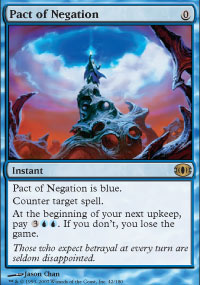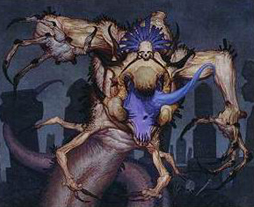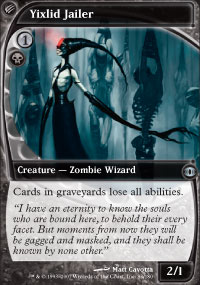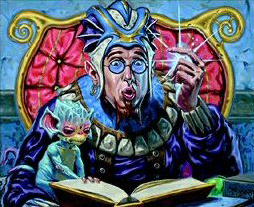
As has been noted by many set reviewers before myself, any card from a new set will have a difficult time making it into any competitive deck, let alone significantly impacting the format. However, with Future Sight, the Vintage players of the world have been given a set that will almost certainly leave an indelible mark on the format. I do not say this for the sake of being sensationalist; I truly believe that this set as a whole will have a bigger impact than any set for some time (that “time” being Mirrodin and Darksteel, collectively). Future Sight offers many mechanics that have never been seen before, in addition to some new twists on old mechanics. While most of the cards I mention here will most likely not see play, some of the cards will be major for the format.
To borrow the standards set forth by Oscar Tan, for a new card to be viable in Vintage, it either has to do something better than a predecessor, do something that no card has done before (see: Mindslaver), or enable other cards in a way that was previously not possible. So, in keeping with these standards, my goal with this article is to inform the reader not only of the viability of the “big” cards that will most likely see play, but also cards that, while they probably will not see play, do have potential.
Cards that are likely to see play:
Pact of Negation: This card has been heralded by some as the second coming of Force of Will. Honestly, I could probably write an entire article on the potential viability of this card. Suffice it to say, this card will see play in Vintage.

The second coming of Force?
Not quite.
Where will it see play and how many copies will be run? Combo would seem to be the obvious choice. In considering combo decks that are currently running the full complement of Force of Wills, I think this card will see play as a 1-of or a 2-of, and maybe a 3-of. Why only one or two? Well, for one, combo sometimes needs to play a reactive counter. If your opponent plays Yawgmoth’s Bargain on turn two, a Pact of Negation is not going to do you much good if you do not have on the table, which you probably will not. Combo just needs more hard counters rather than less for this reason. I see this card working in conjunction with Force of Will, and possibly Misdirection and Mana Drain. If any deck will fully embrace this card, it will be Belcher or Dragon. Whether this will push the decks into the top tier or not, I honestly can’t say, as these decks are not my specialty. It is something to watch out for, though. Finally, I do not see this card as viable in non-combo decks, as the benefit just cannot be captured because the decks typically are not winning on the turn they would play this card. Ultimately, I expect this card to have a big impact, but not a format defining one.
Delay: While I initially scoffed at its possible inclusion, I am now inclined to think that this card is probably better than Mana Leak in Vintage. This is because Delay is a relatively harder counter than Mana Leak in most contexts. First, any spell whose target will not be around three turns later is effectively countered by Delay. This primarily refers to counters, but might also refer to creature removal or bounce. Second, Delay, if it resolves, will always stop a spell from doing what it wants to do right now, whereas Mana Leak sometimes does not. As games drag on, Mana Leak becomes worse and worse, oftentimes being completely dead by the end of the game because an opponent has so much mana. Third, as is the case with Pact of Negation, the drawback of the spell may simply never be realized. Since Delay will most often be played during an opponent’s turn, that opponent will not get his or her spell until Delay’s controller has taken three full turns. That is an eternity in Vintage, especially as far as combo is concerned. Consequently, I see this card competing very hard for the counter slot. Therefore, look for it to replace Mana Leak in Oath of Druids decks in the near future. It could potentially see play beyond this.
Street Wraith: This is the other card that everybody is really excited about, and with good reason. While some have suggested that running this card allows one to run what essentially is a 56 card deck, I am not willing to make that leap, for a few reasons. First, the life loss is not meaningless; creature based decks have become more aggressive and combo decks have become more frivolous with their life points. However, this is not to imply that running Street Wraith is tantamount to running a 56 card deck while starting at 12 life, as that simply is not the case. You typically will not be drawing all four copies in one game; on average I would say to expect one or two. What’s weird about this card is that you never really want to draw it. Sure it can be used as a finisher, but would you run a nearly vanilla 3/4 creature? Certainly not.

This is about how complicated running
Street Wraith is on paper.
The take home message is that whenever you cycle Street Wraith, you are taking a chance on your deck. However, this is exacerbated and mitigated by two separate issues. First, if you get Street Wraith in your opening hand you do not really know where you stand with respect to Street Wraith. Combo often wants to try to figure out precisely how it is going to win from the opening hand, so not knowing what the seventh card is can significantly hurt. Mulliganing becomes a more difficult (and perhaps more regular) event. On the positive side, it makes tutors that put the card on top of you deck (Mystical Tutor, Vampiric Tutor, and Imperial Seal) more powerful in that you can draw the card right now at no additional mana cost. This, I believe, is huge. Rather than having to rely on drawing Ancestral Recall or Brainstorm, one can now just cycle Street Wraith instead and get the same effect (at a cheaper mana cost no less!). I personally am a big advocate of tutor effects; Street Wraith will make them even better.
So what’s the verdict on Street Wraith? You will see him extensively. Combo that is not Oath of Druids will attempt to embrace him immediately, running three or four. Slaver and Stax will also try to pick him up, although to what extent I am not sure. I do not expect to see him in Fish, primarily because the deck is so redundant to begin with. Additionally, sometimes Fish actually wants to squeeze more tools in rather than fewer, meaning there is no room for Wraith. I must say that I am not extremely confidant in these predictions, as the card is so simple, yet so complex for the reasons stated above. However, the impact will be significant, regardless of how things ultimately turn out.
Aven Mindcensor: This card just screams “put me in Fish.” Does it belong there? I am definitely leaning toward yes. Needless to say, any deck packing multiple copies of Grim Tutor will be none too happy to see this card hit the table. However, unlike Meddling Mage, Aven Mindcensor actually cuts off potential answers to it by its own effect. Sure, it can be bounced or removed as easily as the next creature, but not if your opponent cannot actually get to the removal. It is this fact that I think makes the Mindcensor so appealing; the card protects itself. This card stops tutors of all kinds from having any meaningful effect, while also shutting down fetchlands, a huge staple in the premier combo decks of today. If the card becomes too dominant, decks may try to adapt by using something cute like Fire//Ice as an answer that can by cycled, but again, how are you going to get to it? If anything, this will force combo decks to adapt and diversify their threats, probably by leaning back toward the draw-7 route; combo decks have begun to depend too significantly on tutors because there has been no drawback in doing so. This may (and probably will) change with the advent of Aven Mindcensor. On one final note, he can also be sacrificed to Voidmage Prodigy, something that some Fish decks might care about.

Ichorid has some new friends…
Narcomoeba: Apparently, Bridge from Below was not enough for Ichorid, so Wizards decided to go ahead and print Narcomoeba for good measure. This is a very, very solid creature for Ichorid, as it doesn’t leave play at end of turn, it flies, and it realistically can be hardcasted, depending upon the manabase of the Ichorid deck. While this card is not as big as Bridge from Below, it definitely helps Bridge’s cause in addition to making the deck more consistent in general. Again, how much hate Ichorid receives will be crucial.
Edge of Autumn: For what this card does, I have seen considerably less chatter about it than I expected and I am unsure why. I suspect it is because the instant playability of this card does not scream off the cardboard the way that it does for Street Wraith. While the Wraith is potentially a win condition, Edge of Autumn obviously is not. However, this card can almost certainly be cycled whenever one wants to get that extra card. The problem, obviously, is that it stunts one’s manabase in the process, while Street Wraith does not. While I would not advocate this as a 4-of, I believe one or two could have a positive impact on a deck, as it would allow a player to dig when he or she really needss to. Although, this again gets into issues of the utility of the 60th card in your deck vs. having a land in play (similar to Street Wraith). Honestly, only extensive testing will tell. Look for this card in combo of all kinds in the future months. Note that of the cards that I expect to see played, this one has the least amount of my confidence.
Cards that could see some play:
Nix: Steve Menendian suggested that this is the kind of card that would be good “in twenty years.” While this may be true, I imagine you all are interested in what it can do in the near future, rather than the distant future. I would say the answer to whether it will see play soon depends upon the impact that the pacts have in the new metagame. If pacts become more popular, this very cheap counter becomes the obvious answer. Also of note is that this card counters Chalice for zero, although I think this use is a little too narrow for the aforementioned combo decks that are already trying to squeeze in Pact of Negation and Street Wraith.
Shimian Specter: This card is similar to Extirpate in that it has a similar effect; the card is just gotten from the hand rather than the graveyard. While Hypnotic Specter has long ago been dismissed as unplayable, I think this guy has a chance because he is very particular about the card that he removes. One or two swings with this guy against combo would most likely be devastating. Where he would fit in though, is not clear. There have been (very) small rumblings of the return of black control/discard with the advent of so many combo decks running around, so this card may be able to find a place there. I am going to tab this guy with my “dark horse award” for being a card that is underappreciated now, but may see significant play later.

A “fun” card for both players and judges.
Magus of the Moon: Blood Moon is a card that I have long thought to be underutilized. This card bolsters Blood Moon’s chances. For one, you can basically run eight copies if you so choose, meaning that you will be able to get the card fairly consistently. Second, it provides a potential win condition in that there is a 2/2 body on it; redundant Blood Moons were previously useless. So, this one card can potentially be ridden all the way to victory. Stax builds already running Blood Moon may try to implement this card. It is more likely, however, that a new deck or The Mountains Win Again would try to add this card, with possibly good results. I am inclined to think it may be a little too slow, but time will tell.
Summoner’s Pact: The only other pact worth mentioning. While this card may not seem worthy, it can grab two lesser played combo mana sources in Tinder Wall and Elvish Spirit Guide (which are typically found in Belcher). Again, Belcher is not really my area of expertise, so I am uncertain as to whether this card has a significant amount of merit, especially given all the other choices that are available for the deck (Land Grant and Simian Spirit Guide come to mind).
Coalition Relic: The Relic would be looking to replace Darksteel Ingot, which has not seen much play of late. The ability to get extra mana out of it makes it fairly appealing, as I do not believe that the indestructible aspect of the Ingot made it preferable, at all. There is a slight chance that this might slip in to a Stax deck somewhere as a 1-of. However, this card has the least amount of my confidence in this playability category for seeing play.
Horizon Canopy: This is one of those cards that I look at and just go “oh, that’s neat.” While this land is not fetchable and you lose life in order to tap it for mana, the ability to sacrifice it and draw a card is pretty nifty. The colors available with it certainly do not thrill the Vintage community, but perhaps it could just be perceived as producing colorless mana. Fish builds running white might try to add this as a 1-of to get that extra little push, especially with the use of Wasteland leveling off ever so slightly. This card could potentially be combined with Crucible of Worlds, although using Wasteland, Strip Mine, or even Mishra’s Factory is probably just better.

There is no way this is how R&D felt after
coming up with Tolaria West’s name.
Cards that are worth mentioning, but probably will not see play:
Barren Glory: This card is the long awaited tournament legal version of The Cheese Stands Alone. While it is neat, the only way I could see winning with this card would be comboing out via some Wrath effect, like Balance combined with Academy Rector. A combo with this card just seems too clumsy and slow to be effective.
Lost Auramancers: This is a fixed Academy Rector (which is currently unrestricted). While you could play this creature and hope to fetch Yawgmoth’s Bargain in three turns, this is far too slow for Vintage. Besides, Academy Rector does combo pretty well with Cabal Therapy, so any tricks involving removing counters early would be inferior to just running the original combo.
Seht’s Tiger: I mention this card because it would potentially be an answer to Tendrils of Agony that is not Trickbind or Stifle. Why even consider this over either of those? Well, it can’t be Duressed away. Is it worth is at ? Probably not.
Maelstrom Djinn: Cheap fatties have always been a problem for blue. Serendib Efreet and Morphling have long been the only really big men available, and this card might deserve a look. However, by himself, he is still only lethal seven turns after he is played. Since most true control decks nowadays are splashing at least one color, there are better choices available.
Spellweaver Volute: While this card may seem neat, I cannot think of any way this could get terribly broken. I suppose if you got it out early it might lend itself to extra Ancestral Recalling and Brainstorming, but it just seems too costly. While I wouldn’t be shocked if somebody broke it, it seems unlikely.

He’s smiling because he knows that he is
still number one.
Grinning Ignus: This guy can allow you to store some mana for later on. However, Desperate Ritual gets you extra mana right now and is not seeing much play at all to my knowledge. Additionally, I do not perceive any simple way to go infinite.
Haze of Rage: For (and the appropriate number of spells) you can give one of your creatures a power of 20 or more. While this might seem inviting, the alternatives of Tendrils of Agony and Empty the Warrens are just better. Tendrils of Agony is an instant kill and is in a color you actually want. Empty the Warrens doesn’t require that you actually get a sufficient number of spells to win with it this turn, whereas Haze of Rage does. Finally, you need a creature to tack the extra power on to, which is a problem in Vintage sometimes.
Storm Entity: While it might seem good because this is a storm-like card that can’t be Stifled, regular counters will still answer it. Additionally, it does not seem much better than Empty the Warrens. This card might be able to see some play in an aggro deck, as it could be a 4/4 for , which isn’t bad, but I hesitate to say it will see any play.
Dryad Arbor: The long-awaited manland without an activation cost. While the card is eloquent, I do not think there is much it can provide for Vintage, especially because it has summoning sickness, meaning you aren’t tapping it or swinging with it the turn it comes into play. Putting a 1/1 body on what essentially is a “comes into play tapped” land just won’t cut it.
Force of Savagery: This would most likely try to be comboed with Pandemonium or some toughness boosting card (of which there are many, as toughness is generally given more help than power). That being said, it would be a two card combo that does not win the game by itself.
Heartwood Storyteller: You may draw a lot of cards, but I feel like any deck that is able to produce two green mana probably is not going to be drawing into any answers to counter whatever is causing all the drawing. I also do not know of any deck this creature could realistically be added to. Perhaps this card could supplement a new deck.
Virulent Sliver: If there were a card to make a sliver deck viable, this is it. If you can play two of these guys on turn one, you’ll win on turn four if they do not get any help. If you get two of these guys on turn one and have one helper the next turn, then you’ll win on turn three. Heart Sliver might be able to help this guy out. Fish would be a serious problem for such a deck though, as its men would likely be bigger than the slivers. This is definitely a card to think about in the future, though, should slivers somehow become viable.
Glittering Wish: While this is a cheap tutor, there is no viable target. Fire//Ice and Hide//Seek are the only things I could think of tutoring for, and those cards are not worth it at four total mana.
Dakmor Salvage: The first land with the dredge mechanic, Ichorid is obviously looking at this card. However, it comes into play tapped and does not dredge for that much anyway. The other cards in the deck already do better what this card is trying to do.
In hindsight, this article was far more difficult to write than I thought it would be. While it may be because the expansion really is that revolutionary, it probably has more to do with my lack of Johnny skills, which is essentially what such an article asks of its writer. While some of my predictions may be wrong (and probably are), the objective of this article is not to simply make prognostications. Obviously, I do not have future sight (cue forced laughter). Instead, the purpose of this article is to give you a sense of some of the new cards that may soon be seen around the format. In this way, you can hopefully be more prepared for what is to come. Ultimately however, your deck decisions, both in utilizing these cards and in answering them, are up to you. I hope that this article has been helpful in some way for you.
Future Sight promises to be a huge set for the Vintage format. Ichorid will come out very, very strong, with combo not far behind. However, the format will adapt to Ichorid. Adapting to combo though…maybe not so much. The incredible variety of new cards and potentially new strategies that come from this set are definitely a reason for excitement. While the ultimate impacts may not be realized for months or even years, there is no doubt that Future Sight will change Vintage.
Comments